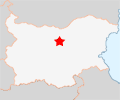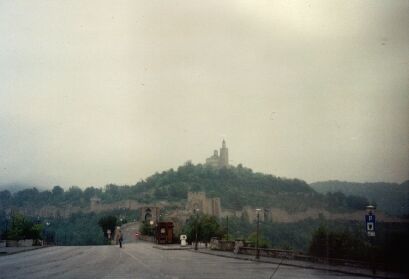Official Name
Велико Търново (Veliko Târnovo). Due to the fact that the name contains a diacritical symbol, it is often simply written as Veliko Tirnovo, Weliko Tarnowo and Veliko Tarnovo. The first spelling in brackets is the phonetically correct one, but to make things easier, 'Veliko Tarnovo' is used in this website. In medieval times, the town was also called Târnovgrad (grad=town). The word Veliko simply means 'Great', tempting the interested reader to speculate on the existence of a place called 'Small Tarnovo'. There is - but this small town, in Bulgarian Malko Târnovo, is far away in the remote south-east corner of the country (see →surroundings of Burgas).
Location

| ||
| Veliko Tarnovo |
Veliko Tarnovo is a town in the centre of North Bulgaria, north of the long Стара Планина (Stara Planina aka Balkan Mountain Range). In and around the city, the small Янтра (Yantra) river winds its way between the mountains in a deep valley, before it flows northwards to the mighty Danube river. South of the town is the Шипка (Shipka) pass - the gateway to the →Valley of Roses, the old city of →Stara Zagora (around 100 km) and other destinations in Southern Bulgaria. Heading north will bring you to →Ruse at the Danube river (also around 100 km).
Population
Some 75,000.
Orientation
The town straddles the deep valley of the Yantra river, which makes it a very interesting place for its location alone. The Yantra meanders around central Царевец (Tsarevets) hill, making it almost an island. West of the hill, the old town centre stretches atop a long spur, with houses towering high above the river. South of the city there's another mountain - the green Света Гора (Hl Mountain) park. Centuries ago, famous monasteries occupied the top of this mountain. Due to the unusual location, a long tunnel under the old city centre was necessary to connect Veliko Tarnovo with the railway network. And so the train station is quite far away from the centre in the south. The narrow lanes in the centre give a first impression of what the place might have looked like centuries ago. The newer part of the town stretches west of the old town and doesn't interfere at all in the special atmosphere of the place.
History
Thracians and later on ancient Romans founded and developed first settlements here since the 5th century. Under the rule of emperor Justinian, a Byzantine fortress was erected atop Tsarevets hill. In the 7th century, the region was conquered by Slavic tribes. The real history of town didn't start before the year 1185. At that time, the place was first mentioned in connection with a large uprising against Byzantine. This uprising was led by the two brothers Asen and Peter (see also →History of Bulgaria) and initiated the foundation of the Second Bulgarian Empire. Veliko Tarnovo became the capital of this empire, which lasted from 1187 to 1393. And so, the town was soon to be the second most important town in the Balkans, only to be outdone by →Constantinople of course. Veliko Tarnovo flourished economically and culturally. A literature school was founded, attracting even students from Russia. This came to an abrupt halt in July 1393. After a three monts siege, Ottomans occupied and destroyed the town completely. Later on, Veliko Tarnovo was partially rebuilt and played a more or less important role during the almost 500 years long Ottoman occupation. In 1877, the town was eventually liberated by the Russian Army. In the past as well as today, arts and crafts play an important role. Additionally, tourism became a major source of income during the last years.
Getting there / transportation
It's not very easy to get to Veliko Tarnovo on a train, since there are only a few direct trains. When coming from →Sofia, it's necessary to go to Gorna Orjahovitsa north of Veliko Tarnovo by train and then by bus. Among other trains, the international train from →Bucharest to →Istanbul stops in Gorna Orjahovitsa. From there, direct trains also run to →Varna. Other connections include trains to Kasanlak in the →Valley of Roses, from where it's easy to get to →Plovdiv. There are also some trains to →Ruse in the North.
Of course, it's also possible to jump on a bus to go straight to the above-mentioned destinations. The central bus terminal of Veliko Tarnovo can be found west of the old city centre in the new town.
Unfortunately, there's not much left from the time, when Veliko Tarnovo was capital of the Second Bulgarian empire, since the town was completely destroyed in 1393. The few remainings include the Tsarevets Citadel on the top of the hill with the same name (admission fee is 3 Lv). On the same hill, there's an old church and beneath the church the ruins of the Royal Palace, which is under reconstruction at the moment (well, this is as of 1996). From this place, all in all 22 kings ruled the country, which is why Veliko Tarnovo is also called City of Tsars. Further to the north, there's the Execution Rock, from where the doomed were thrown into the Yantra river.

| ||
| View of Tsarevets hill at lousy weather... |
When walking west of the hill along Stefan Stambolov rd, you will soon enter the old city centre with many houses built in the distinctive Bulgarian revival style, museums and churches. Down in the valley, a narrow bridge leads over the river. Behind the bridge, there's the obelisk-like 1185 monument. From there, it's possible to climb another hill called Света Гора (Sveta Gora, holy mountain). The vista of the old town from there is stunning: Houses were built above the edge of the rocks - some of them seem to fall down in an instant. Veliko Tarnovo is one of those places, where it's just fun to stroll around without heading for a specific place. There's something to discover in every corner of the old town. Additionally, countless restaurants and small shops selling art and traditional handicrafts are dotted around the old town.
In the vicinity of Veliko Tarnovo, less then 10 km north to be exactly, there's a small town called Арбанаси (Arbanasi), which was probably founded by Albanians. The town flourished during the Ottoman occupation and is well preserved. There are some 100 architectural monuments in Arbanasi, among them some monasteries and churches.
Another interesting town to visit is Етър (Etâr) - an ethnographic village museum, where traditional craftwork is on display.
South of Veliko Tarnovo, a small road leads to the 1,300 m high Шипка (Shipka) pass. In the 19th century, a famous battle for the important pass took place between the Ottomans and Russians. Although outnumbered, Russians and Bulgarians won the battle, leaving some 200,000 soldiers on the battlefield. There's a large monument on the pass commemorating the victims. The Shipka pass is the gateway to Southern Bulgaria.
Unfortunately, I do not remember where exactly I stayed in Veliko Tarnovo. However, there's no lack of hotels and private accommodation. The latter is often offered at the bus and train stations.
- veliko-tarnovo.net/index_engl.php Well-done and very helpful official website of Veliko Tarnovo. Here's the English version.
Do you have or do you know a good website about Veliko Tarnovo? Don't hesitate, let me know! After checking it, I would love to add it to the link list. You can submit a link by using the →contact form. Note that commercial websites will be treated differently.
©2024 Europe-East.com

 Albania
Albania Bulgaria
Bulgaria